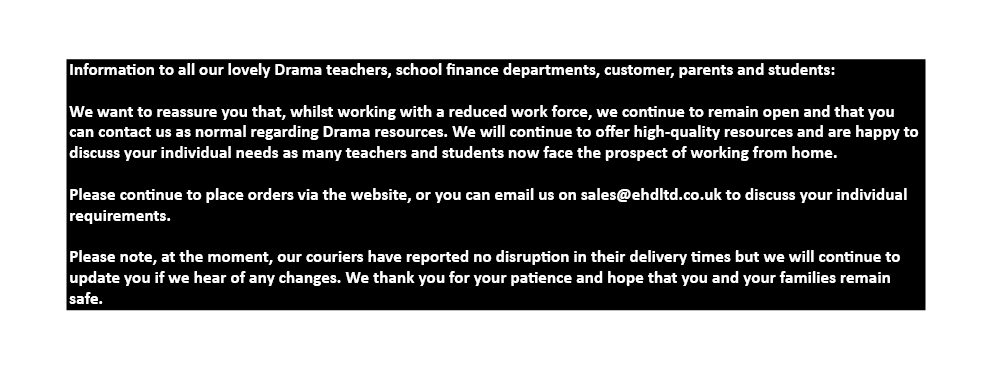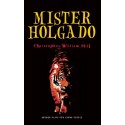Check items to add to the cart or select all
You can choose to work through this booklet sequentially, or you can dip in and out as you see fit to accompany your teaching.
The resources encourage your students to consider the context of the play, exploring the world of child psychology, the nature versus nurture debate, the Kafka-esque atmosphere of the play, the similarities between Hill's writing and that of Kafka's The Metamorphosis and The Trial, the play's Eastern European/Gothic setting and the reasons many critics have likened Hill's work to that of Tim Burton.
The booklet also provides you with a wealth of practical teaching approaches, from off-text games to rehearsal strategies, to director-led group work. Students will be inspired to explore each scene of the play the play from a practical perspective, forming their own interpretations and performance ideas. Each section of the booklet is accompanied by detailed teaching ideas, guiding you through each activity and providing you with the handouts needed as well as suggestions for extension work. Students are encouraged to take inspiration from influential figures of the theatre world, looking at ways in which the work of Brecht and Stanislavski might lend themselves to this text.
Each character is analysed and explored and students are encouraged to explore the Doctor's control over his family, the complex relationship between father and son, the changes in the Mother, the power and status within the family and students will look specifically at messages the playwright might be presenting regarding the world of developmental psychology. Students are introduced to the work of Brecht and encouraged to apply his ideas to their performance work. Students will also use techniques such as tableaux, gesture, role-on-the-wall, placards, timing and tempo and will perform rehearsed pieces of text to the class, applying the ideas they have explored. Each character is approached from a performance perspective and students are encouraged to evaluate each other's performances and justify performance decisions they have made.
The resource pack encourages your students to approach this wonderful text from the perspective of a performer and/or technician, encouraging them to research, experiment, evaluate and alter their ideas as they go. Various activities also allow students to direct their peers and helps shape them in to critical, evaluative performers. The final section of the booklet provides students with a wealth of exam-style questions, assessing their understanding of the play and encouraging them to write about their interpretations, character preparation, rehearsal processes, technical ideas and performance.
Whether you are looking to teach a play for a practical or written exam, or whether you merely wish to introduce your new GCSE students to approaching texts for performance, this is the resource pack for you.
The resources encourage your students to consider the context of the play, exploring the world of child psychology, the nature versus nurture debate, the Kafka-esque atmosphere of the play, the similarities between Hill's writing and that of Kafka's The Metamorphosis and The Trial, the play's Eastern European/Gothic setting and the reasons many critics have likened Hill's work to that of Tim Burton.
The booklet also provides you with a wealth of practical teaching approaches, from off-text games to rehearsal strategies, to director-led group work. Students will be inspired to explore each scene of the play the play from a practical perspective, forming their own interpretations and performance ideas. Each section of the booklet is accompanied by detailed teaching ideas, guiding you through each activity and providing you with the handouts needed as well as suggestions for extension work. Students are encouraged to take inspiration from influential figures of the theatre world, looking at ways in which the work of Brecht and Stanislavski might lend themselves to this text.
Each character is analysed and explored and students are encouraged to explore the Doctor's control over his family, the complex relationship between father and son, the changes in the Mother, the power and status within the family and students will look specifically at messages the playwright might be presenting regarding the world of developmental psychology. Students are introduced to the work of Brecht and encouraged to apply his ideas to their performance work. Students will also use techniques such as tableaux, gesture, role-on-the-wall, placards, timing and tempo and will perform rehearsed pieces of text to the class, applying the ideas they have explored. Each character is approached from a performance perspective and students are encouraged to evaluate each other's performances and justify performance decisions they have made.
The resource pack encourages your students to approach this wonderful text from the perspective of a performer and/or technician, encouraging them to research, experiment, evaluate and alter their ideas as they go. Various activities also allow students to direct their peers and helps shape them in to critical, evaluative performers. The final section of the booklet provides students with a wealth of exam-style questions, assessing their understanding of the play and encouraging them to write about their interpretations, character preparation, rehearsal processes, technical ideas and performance.
Whether you are looking to teach a play for a practical or written exam, or whether you merely wish to introduce your new GCSE students to approaching texts for performance, this is the resource pack for you.
You may also be interested in the following product(s)
Mister Holgado by Christopher William Hill
£11.99
|
Plastic Tiger Mask
£3.49
|





